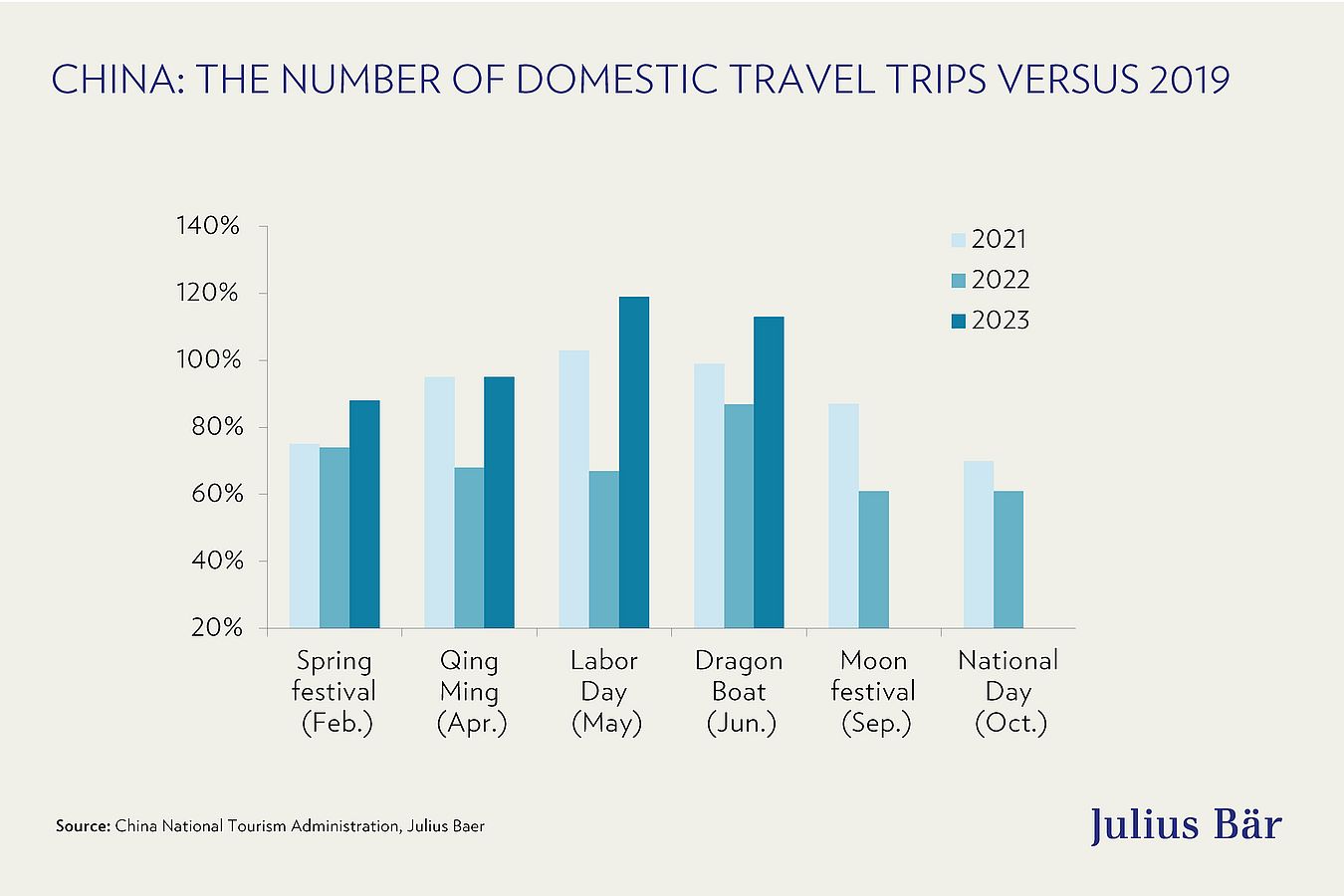 | |||
|
Esta página não está disponível no idioma selecionado. Sua preferência de idioma não será alterada, mas o conteúdo desta página será exibido em inglês.
Soaring tourist numbers brighten the summer picture
The Chinese economy is in dire straits but, with its leadership on holiday, any quick change of course is unlikely. Fortunately, the rest of the world is on holiday too, with global tourist numbers indicating good health among consumers. Our Research Weekly experts advise looking from Asian to Latin American equities and take a constructive view of the Asian Tourism subtheme.
Key take-aways
- Three-month outlook for Asia downgraded from Bullish to Neutral following mounting economic concerns in China.
- Preference for Latin America equities, noting less sensitivity towards China and supportive domestic tailwinds.
- Cross-border travel within Asia has recovered – we remain Constructive on the Asian Tourism subtheme.
China: Weak credit dynamics underpin economic headwinds
Credit dynamics in the Chinese economy slowed sharply in July, led by very weak new bank loans. In particular, loans to households turned negative again, indicating continued weak consumer confidence. Bank lending to corporates last month also turned out lower than in previous years. The low appetite to borrow among private households and businesses reflects the sluggish recovery of domestic demand.
Thus, the latest credit data complement the weak trade data and the decline in consumer prices, which also point to economic headwinds. There is an increased risk of deflation in China due to sluggish domestic demand dynamics, a weak labour market, and the crisis in the real estate market.
USD bond investors advised to sell Chinese bonds on rallies
The Chinese property sector’s worsening cash crunch has resulted in many defaults. While the government announced property easing policies that exceeded the market’s low expectations, there is a time lag between implementation and results and, unfortunately, the developers lack time. Banks will likely tighten lending to the sector despite the government’s instruction to provide liquidity to the sector. Developers’ woes will likely contribute to the Chinese economy’s deflationary trend. There have been no signs of government support or a bailout so far.
We retain our view that support measures need to include rescuing liquidity-stricken developers for a sustainable turnaround of the physical property sector.
Banks have tightened lending to private property developers in China.
Global investors should calibrate their positions on Chinese equities
Amid the slew of negative headlines that have hit the Chinese market, we believe that the market’s focus is quickly shifting to the financing challenges of the investment trust industry in China. We believe a large portion of the trusts may be investing in the Chinese property market, whose lingering problems are causing a meaningful drop in asset values.
The entire trust industry in China manages over CNY 20 trillion. One-fourth to one-third of their assets is in property trusts, which is the vulnerable part, in our view. Barring a prompt and effective policy response, the market may continue to suffer from fragile investor sentiment in the near term, so it may go down towards the lower end of our expected trading range rather than upwards.
We continue to recommend that global investors calibrate their China positions, although the trim-on-bounce window that we previously suggested investors to focus on may now be gone.
Asia equity strategy downgraded to Neutral
Amid these concerns, Chinese equities have wiped out all market gains since the politburo meeting in July. The increase in negative headlines and a lack of policy stimulus underpins our view that the stock market may now be trading at the lower end of the range for the rest of the year.
We currently have a Neutral rating for most emerging markets (EM) in Asia and expect them to perform in line with global benchmark indices. China accounts for 35.6% of EM Asia, followed by Taiwan (19.0%), where valuations are at ten-year highs, and South Korea (15.7%), where the market has rerated considerably over the past months despite earnings cuts.
We have thus downgraded our short-term outlook for EM Asia from Bullish to Neutral, as our overweight stance on India (18.8%) and Southeast Asia (10.9%) do not offset the muted return expectations for the region. EM equities will struggle to outperform developed markets if the current headwinds from China persist.
Other stories this week
- Oil prices rise above USD 85 per barrel but we stick to USD 75 on a 12-month horizon.
- Lower US inflation makes another rate hike by the Fed less likely.
- UK showed resilient GDP growth in Q2 2023 and a recession has likely been avoided.
Bullish outlook for Latin American equities
Nevertheless, we reaffirm our bullish outlook for equities in Latin America (LatAm). The region benefits from low valuations, upward growth revisions, and a supportive disinflation trend, which set the stage for aggressive rate cuts.
Also, LatAm may not be as vulnerable to worsening investor sentiment in China. The historical correlation between China and Brazil (the largest equity market in LatAm) has fallen significantly over the past year. In our view, this lower sensitivity to China is evidence that investors consider domestic factors, such as macro tailwinds as more important than the positive links to a recovery in the Chinese economy.
Buoyant recovery in Asian Tourism continues
Despite the aforementioned key macroeconomic indicators showing a lukewarm economy, tourism in China is one of the few areas where the recovery is solid, consistent, and encouraging. Tourism-related revenues have recovered to 95%–100% of the pre-pandemic level. Travel by high-speed railway, self-driving, and other short-distance tours are the most popular travel methods.
The number of domestic tourism trips has already surpassed the pre-pandemic level during the last two key festivals (Labor Day and Dragon Boat).
For other Asian countries, inbound tourist activities have also generally strengthened quarter by quarter. Visitor arrivals in Japan reached 4.8 million in Q1 (59% of pre-Covid) and increased to 5.9 million in Q2 (69% of pre-Covid). Based on June data, Japan’s inbound tourists are more geographically diverse now. Chinese tourists used to be the single largest group (30% of total) but are now down to 10%. Korean tourists have overtaken the first spot and now constitute 26% of total tourists.
China’s leading domestic online travel agency recently mentioned that its domestic booking volume is now 60% above pre-pandemic levels. Meanwhile, China’s outbound travel booking has recovered to 60% of pre-pandemic levels, which is a reflection of the ongoing capacity constraints for international flights.
Overall, we remain Constructive on the Asian Tourism theme, which has outperformed global equities so far this year. Valuations have recovered but are not expensive.




No comments:
Post a Comment